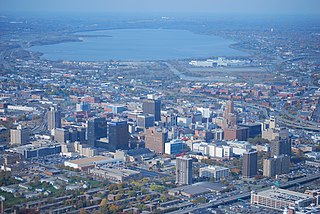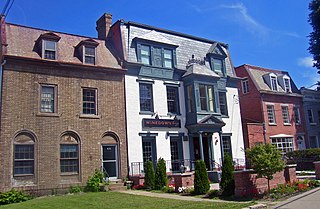
Troy is a city in the U.S. state of New York and the seat of Rensselaer County. The city is located on the western edge of Rensselaer County and on the eastern bank of the Hudson River. Troy has close ties to the nearby cities of Albany and Schenectady, forming a region popularly called the Capital District. The city is one of the three major centers for the Albany Metropolitan Statistical Area (MSA), which has a population of 1,170,483. At the 2010 census, the population of Troy was 50,129. Troy's motto is Ilium fuit, Troja est, which means "Ilium was, Troy is".

Union College is a private liberal arts college in Schenectady, New York. Founded in 1795, it was the first institution of higher learning chartered by the New York State Board of Regents, and second in the state of New York. In the 19th century, it became the "Mother of Fraternities", as three of the earliest Greek letter societies were established there. After 175 years as a traditional all-male institution, Union College began enrolling women in 1970.

Downtown Syracuse is the economic center of Syracuse, New York, and Central New York, employing over 30,000 people, and housing over 4,000.

Vale Cemetery is a historic rural cemetery and the largest cemetery in Schenectady, New York. It opened on 21 October 1857 when the Rev. Julius Seely dedicated what was then termed "the Vale". It has tripled its size since opening and today it holds the remains of some of the most notable persons in Upstate New York. In 1973, a 35-acre tract of unused and abandoned cemetery land around the ponds of Cowhorn Creek was sold to the city of Schenectady to form Vale Park.

The New York State Canal System is a successor to the Erie Canal and other canals within New York. Currently, the 525-mile (845 km) system is composed of the Erie Canal, the Oswego Canal, the Cayuga–Seneca Canal, and the Champlain Canal. In 2014 the system was listed as a national historic district on the National Register of Historic Places in its entirety, and in 2016 it was designated a National Historic Landmark.

The Nott Memorial is an elaborate 16-sided stone-masonry building which serves as both architectural and physical centerpiece of Union College in Schenectady, New York. Dedicated to Eliphalet Nott, president of Union for a remarkable sixty-two years (1804–1866), the 110-foot (34 m) high by 89-foot (27 m) wide structure is a National Historic Landmark, noted for its distinctive and colorful Victorian architecture.

This is intended to be a complete list of properties and districts listed on the National Register of Historic Places in Orleans County, New York. The locations of National Register properties and districts may be seen in a map by clicking on "Map of all coordinates". Two listings, the New York State Barge Canal and the Cobblestone Historic District, are further designated a National Historic Landmark.
Edward Tuckerman Potter was an American architect best known for designing the 1871 Mark Twain House in Hartford, Connecticut. With his half-brother William Appleton Potter, he also designed Nott Memorial Hall (1858–79) at his alma mater, Union College, Schenectady, New York. Both the Mark Twain House and Nott Memorial Hall are National Historic Landmarks.

Franklin School is a historic school located at Schenectady in Schenectady County, New York. It was built in 1907 and is a two-story, red brick "H" shaped institutional building in the Georgian Revival style. It is trimmed with yellow brick and stone. There are massive yellow brick pilasters at the corner of the pavilions and recessed rectangular panels. It operated as a school by the Schenectady City School District until 1974.
The National Register of Historic Places listings in Syracuse, New York are described below. There are 109 listed properties and districts in the city of Syracuse, including 19 business or public buildings, 13 historic districts, 6 churches, four school or university buildings, three parks, six apartment buildings, and 43 houses. Twenty-nine of the listed houses were designed by architect Ward Wellington Ward; 25 of these were listed as a group in 1996.
William Lee Stoddart (1868–1940) was an architect best known for designing urban hotels in the eastern United States. Although he was born in Tenafly, New Jersey, most of his commissions were in the South. He maintained offices in Atlanta and New York City.

Schenectady City Hall is the seat of government of the city of Schenectady, New York, United States. Designed by McKim, Mead, and White, the building was constructed between 1931 and 1933. It is located on the block between Clinton, Franklin, Jay and Liberty streets. It is built in a revival of the Federal Style, the dominant style of American architecture from 1780 to 1830. Its most prominent features include the square clock tower, with its gold-leaf dome and weathervane, and the Ionic neoclassical portico. It houses not only city government but the local office of U.S. Rep. Paul Tonko.

There are 69 properties listed on the National Register of Historic Places in Albany, New York, United States. Six are additionally designated as National Historic Landmarks (NHLs), the most of any city in the state after New York City. Another 14 are historic districts, for which 20 of the listings are also contributing properties. Two properties, both buildings, that had been listed in the past but have since been demolished have been delisted; one building that is also no longer extant remains listed.

The U.S. Post Office in Schenectady, New York, is located at Jay and Liberty streets just north of City Hall. It serves the 12305, 12307 and 12308 ZIP codes, which covers the city. It is a brick Classical Revival building erected in 1912 and added onto extensively in 1933. At that point in time its main entrance was moved to Jay Street.

The General Electric Realty Plot, often referred to locally as the GE Realty Plot, GE Plots or just The Plot, is a residential neighborhood in Schenectady, New York, United States. It is an area of approximately 90 acres (36 ha) just east of Union College.

The Union Street Historic District extends along a section of that street in Schenectady, New York, United States. Covering roughly two miles (3.2 km) of both sides of the street, it includes 184 buildings in its 65 acres (26 ha).

Downtown Schenectady is the central business district for the city of Schenectady, New York. It originated in the 1820s with the moving of the commercial and industrial interests east from the original 17th and 18th century settlement, spurred on by the development of the Erie Canal. Home to the headquarters and major manufacturing plants of two large corporations, General Electric and American Locomotive Company, Downtown Schenectady catered to tens of thousands of workers in its heyday. Typical of the post-industrial Northeastern United States and Upstate New York in particular, Downtown Schenectady saw a decline in manufacturing and population starting in the 1970s. Recent construction and renovation has caused the downtown area to become an entertainment mecca for New York's Capital District anchored by Proctor's Theatre.

Horace Mann School, also known as Craig Street School, is a historic school building located at Schenectady, Schenectady County, New York. It was built in 1907–1908, and is a two-story, "I"-shaped brick building above a reinforced concrete basement. The building includes some Neoclassical design elements including large fanlights, a projecting modillioned cornice, and monumental corner pilasters. A one-story rear addition was constructed in 1986. The Horace Mann School closed in 1981. The building is identical to the former Franklin School, listed on the National Register of Historic Places in 1983.

St. Columba's School is a historic school building located at Schenectady, Schenectady County, New York. It was built in 1923, and is a three-story, reddish-brown brick building in the Collegiate Gothic style. It features white Indiana limestone buttress amortizements, pinnacles, and a crenellated parapet. The school closed in 1974, and since 1976 the building has housed the local Boys and Girls Club.

YMCA of Schenectady is a historic YMCA building located at Schenectady, Schenectady County, New York. It was built between 1926 and 1928, and is a four-story and basement, red brick building with cast stone detailing. An addition was constructed in 1968. It is nearly rectangular in plan overall – with E-shaped upper floors. The front façade features twin main entrances and is dominated by an elevated two-story verandah with substantial wood columns. YMCA occupied the building until 2014.

















